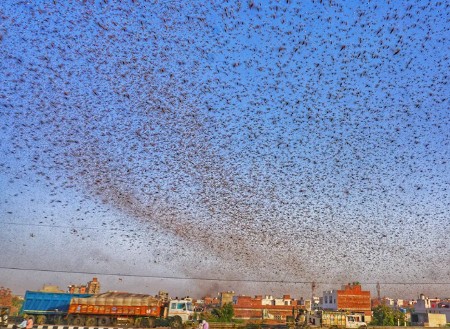May 29, 2020 – In a period of a few weeks the Indian subcontinent has experienced a quadruple disaster.
First, the growing number of COVID-19 cases in India reached nearly 170,000 as of today. Even with an average daily rise of 2% in new cases, India was reopening its economy and likely will see a significant increase in COVID-19 infections in the next few weeks. The implications for the country’s health infrastructure are dire.
Second, India is in the midst of a heatwave producing “red alert” temperatures in excess of 47 Celsius (116 Fahrenheit) in New Delhi and 50 Celsius (122 Fahrenheit) in the state of Rajasthan. Much of the country’s 1.3 billion have been sheltering in place in homes with suboptimal living conditions and limited access to cooling. Opening windows and fans has provided little relief. With homes with few screens, open windows are providing access for mosquitoes carrying other infectious diseases like malaria, and Dengue. Already overcrowded, and now suffering from extreme heat, lower-income communities across the country are in serious danger.
Third, Eastern India in the last week has been whacked by Cyclone Amphan. Described as a superstorm, the cyclone has caused massive flooding, loss of homes and lost lives. It has left more than 14 million without power and many without a roof over their heads to shelter in place.
Fourth, locusts have returned to India in giant swarms. These are part of the same phenomenon that has appeared in East Africa. They have now made the leap to the subcontinent appearing in places not seen for multiple decades. Each of these desert locusts can consume food equal to its body weight daily. An average one square kilometer swarm contains up to 40 million locusts and eats as much food as 35,000 people per day. The threat to India’s food security is palpable.

All of this happening in such a short window of time would seem to be overwhelming for any government let alone India, the largest democracy in the world, and a nation riven by a caste system and ethnic and religious divisions. Three of the four crises mentioned above are directly linked to global warming — the heatwave, the superstorm, and the locusts. The fourth, COVID-19, has some scientists arguing that its appearance and growth are evidence of climate change as well.
There is no doubt that there are parallels between the advent of COVID-19 and climate change. Both are global challenges requiring a coordinated global response. The heatwave is directly contributing to the COVID-19 infection rate by making sheltering in place and social isolation harder to do. In an Associated Press article this week, Sunita Narain, of the New Delhi Center for Science and Environment, states “The world will not get a chance to breathe anymore. The ferocity of crises are increasing and they’re not going to be spaced out.”
India’s current dilemma is one that foreshadows what many other country’s futures may look like as they face a confluence of challenges, in particular those brought on by climate change. Add a pandemic or other disease outbreaks to the mix and you have a formula for impending disaster. Is this an emerging pattern for many areas of our planet and the nations located in them as habitability becomes compromised by atmospheric warming and the many additional challenges we humans have created for ourselves?
As much as COVID-19 has occupied a prominent place in producing policies and actions currently governing most of us on the planet, it is clear that no country can afford to ignore what global warming is already doing. The effort to protect citizens from the pandemic can be a stepping stone to action to ensure that climate change doesn’t end up being even more disruptive to citizens’ lives and the economic security of nations.
For India in its current dilemma, the country needs to implement multiple strategies to deal with the current climate change threat. This means rehabbing existing buildings and homes with low-cost solutions from planting trees nearby to putting screens on windows and to installing cool roofs to help with indoor environments and to lessen the urban heat-island effect. Transitioning to a low-carbon economy much faster than the current government snail pace changes would also help because if trends continue current areas of India that are today marginally habitable, will in the very near future become uninhabitable.
The Trump-maligned World Health Organization which he withdrew the United States from today sees the pandemic and global warming as integrally linked because risk factors for both impacts the poorest countries and people on the planet. Global warming is a facilitator of pandemics because it places burdens on perilously weak health infrastructures in many countries, particularly those in the Developing World. And the health threat of COVID-19 is further compounded by poor atmospheric environmental conditions such as human-caused air pollution.















